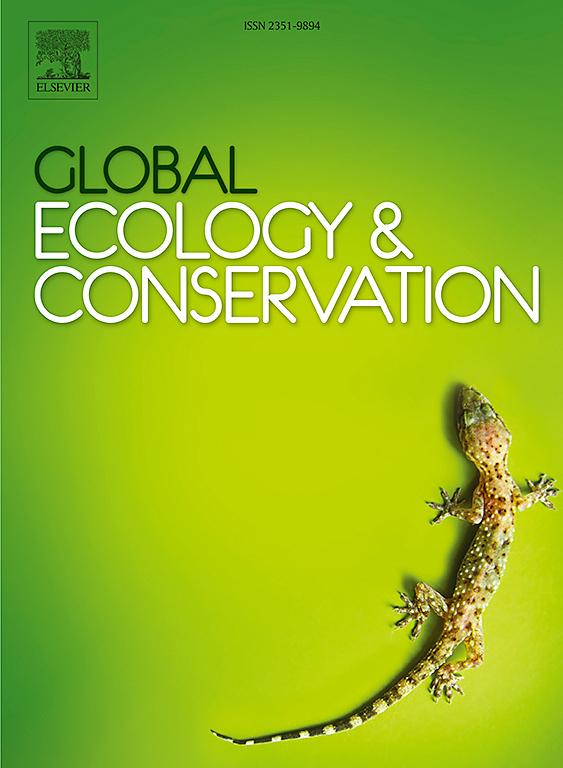The Fen that vanished: The untold story of drainage and peat extraction in Bagno Chlebowo peatland with implications for nature conservation
IF 3.5
2区 环境科学与生态学
Q1 BIODIVERSITY CONSERVATION
引用次数: 0
Abstract
Peatlands have been among the world's fastest-disappearing ecosystems, facing human pressure, especially over the last two centuries. The drainage of peatlands has long been pursued to expand agricultural and forestry areas as well as for peat extraction. One of the most degraded peatlands in western Poland is the Bagno Chlebowo, of which a small part is legally protected, having a raised bog status. The peatland has been undergoing drainage and peat mining since the 19th century, and regardless of its partial protection since 1959, it continues to be subjected to drainage, further compromising the function of the nature reserve. Our research focuses on reconstructing the impact of anthropogenic pressure on the state of the peatland over the last 600 years. We applied palaeoecological methods to reconstruct changes in water table levels, acidity (pH) and local plant cover over time. Additionally, we utilized historical maps to gather data on the area's land use and land cover changes. Our findings reveal that drainage and peat harvesting significantly increased the pH level of the peatland, consequently promoting Sphagnum expansion. These recent changes in vegetation cover and increased acidity have led to inaccuracies in correctly identifying peatland type. Therefore, the palaeoecological record makes us question its current protection status as a true raised bog, suggesting that the site was a fen for most of the time of its functioning. We demonstrate that long-term reconstructions are, therefore, substantial for nature conservation to (1) properly assess the status of wetlands, (2) identify baseline conditions, and (3) plan suitable restoration and protection methods.
消失的沼泽:巴尼奥·克雷博沃泥炭地不为人知的排水和泥炭开采故事及其对自然保护的影响
泥炭地是世界上消失最快的生态系统之一,面临着人类的压力,尤其是在过去的两个世纪里。长期以来,泥炭地的排水一直是为了扩大农业和林业面积以及开采泥炭。Bagno Chlebowo是波兰西部退化最严重的泥炭地之一,其中一小部分受到法律保护,拥有沼泽地位。自19世纪以来,泥炭地一直在排水和开采泥炭,尽管自1959年以来对其进行了部分保护,但仍在继续排水,进一步损害了自然保护区的功能。我们的研究重点是重建过去600年来人为压力对泥炭地状态的影响。我们应用古生态学方法重建了地下水位、酸度(pH)和当地植物覆盖随时间的变化。此外,我们利用历史地图收集了该地区土地利用和土地覆盖变化的数据。研究结果表明,排水和采收泥炭显著提高了泥炭地的pH值,从而促进了泥炭藻的扩张。最近这些植被覆盖的变化和酸度的增加导致了正确识别泥炭地类型的不准确性。因此,古生态记录让我们质疑它目前作为一个真正的凸起沼泽的保护状况,这表明该遗址在其功能的大部分时间里都是一个沼泽。因此,我们证明了长期重建对于自然保护(1)正确评估湿地状况,(2)确定基线条件,以及(3)规划合适的恢复和保护方法是重要的。
本文章由计算机程序翻译,如有差异,请以英文原文为准。
求助全文
约1分钟内获得全文
求助全文
来源期刊

Global Ecology and Conservation
Agricultural and Biological Sciences-Ecology, Evolution, Behavior and Systematics
CiteScore
8.10
自引率
5.00%
发文量
346
审稿时长
83 days
期刊介绍:
Global Ecology and Conservation is a peer-reviewed, open-access journal covering all sub-disciplines of ecological and conservation science: from theory to practice, from molecules to ecosystems, from regional to global. The fields covered include: organismal, population, community, and ecosystem ecology; physiological, evolutionary, and behavioral ecology; and conservation science.
 求助内容:
求助内容: 应助结果提醒方式:
应助结果提醒方式:


